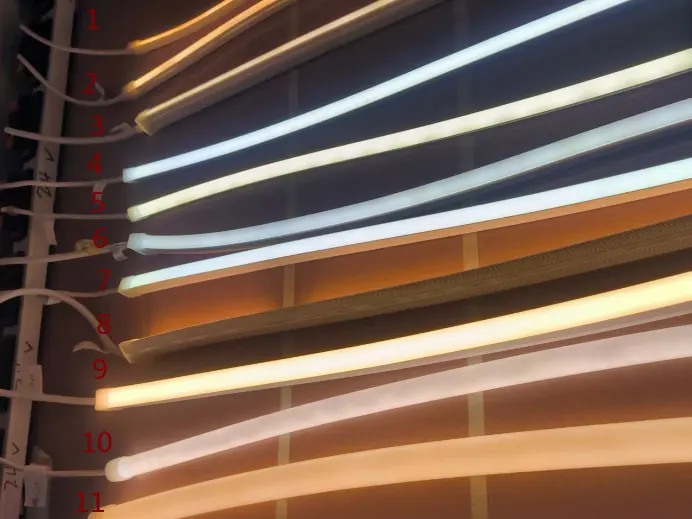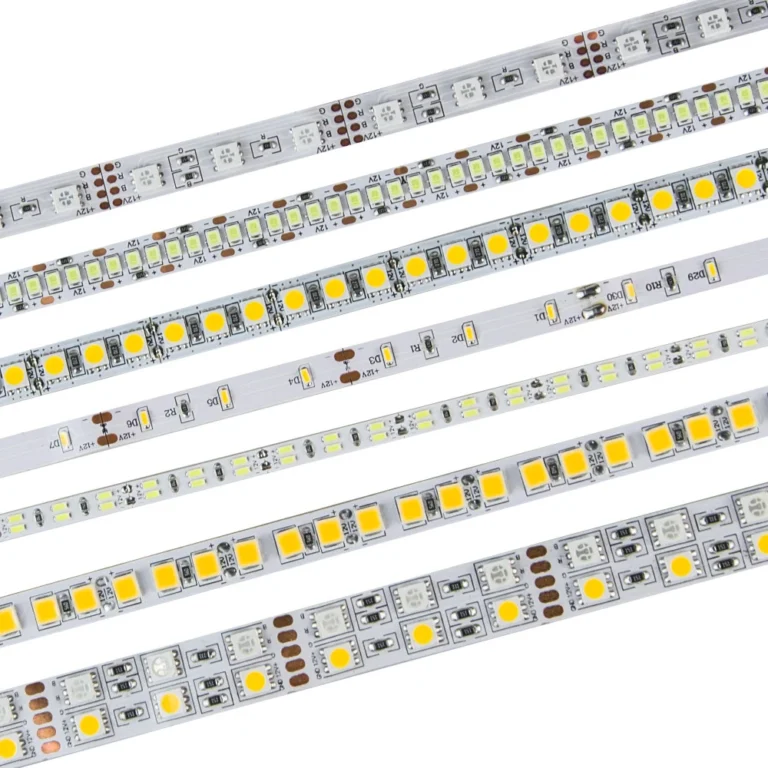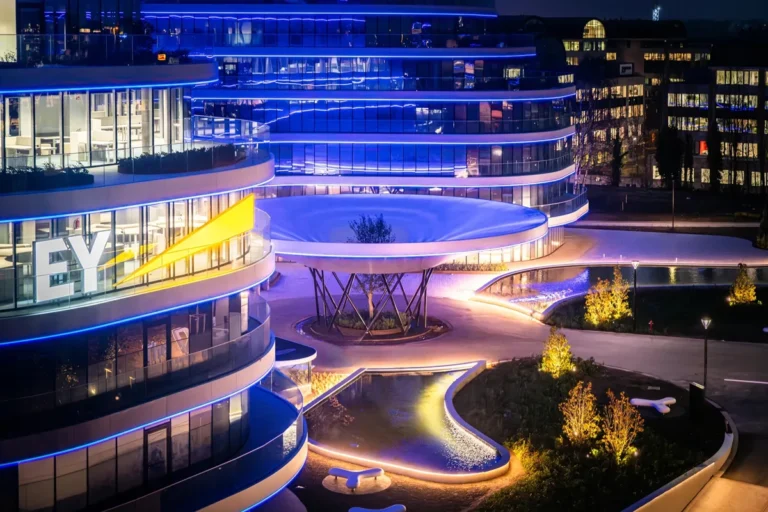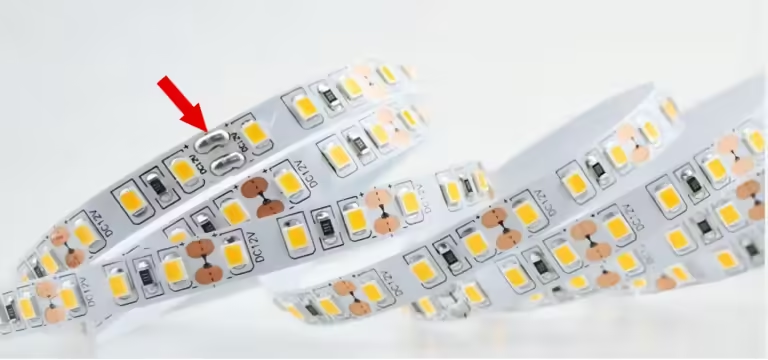谈到动态RGB照明,大多数人会想到低压直流可寻址灯条。 但近年来,越来越多的承包商和照明专业人士正在为大型户外和建筑项目选择交流可寻址的 LED 灯带灯。 为什么? 因为交流 RGB 条带可以运行高达 50 米而不会降压,不需要大量电源,并提供即插即用的便利。 直流带提供精细的控制和灵活性,而交流版本在简单、距离和成本效益方面获胜——尤其是在 110V 或 220V 区域。 在本文中,我们将探讨交流和直流可寻址 LED 灯条之间的主要区别,并帮助您确定下一个项目的正确选择。

什么是交流可寻址LED灯条?
交流可寻址LED灯带是高压RGB灯条,无需低压电源即可显示动态照明效果。 这些条带设计用于直接与 110V 或 220V 交流输入一起工作,使用内置整流电路将交流电转换为直流电,实现一致和安全的操作。
与需要外部控制器和电源适配器的标准直流可寻址条不同,交流 RGB 灯带通常采用即插即用套件,非常适合长距离安装(一次运行高达 50 米),而不会出现亮度下降。
这些条带通常是半可寻址的,这意味着每个片段(通常为 1 米或半米)可以显示不同的颜色或追逐效果,具体取决于内置的 IC 类型。
常见的IC选项包括:
SM16703/SM16716:支持段级动态效果。
TM1934 或类似:常用于户外防水应用。
基于 MCU 的内部 IC:内置于 AC 驱动模块中的自定义 IC,以实现特定效果。
主要功能
直接适用于 110V 或 220V
长单次运行能力(高达 50m)
IP65–IP68 防水选项
安装简便,适合户外或商业照明
它们可以在没有控制器的情况下使用 Bulit-in 程序工作
什么是直流可寻址LED灯带灯?
DC 可寻址 LED 灯带灯是低压 RGB 灯条,允许使用外部控制器进行像素级照明控制。 它们通常在 5V、12V 或 24V DC 下运行,并广泛用于装饰、标牌和动画照明项目。
主要控制类型有两种:
SPI(串行外设接口):
非常适合复杂的照明效果和像素控制。 每个 LED(或组)都有自己的地址。
普通IC:WS2812B、WS2811、SK6812、UCS1903、APA102。
DMX(数字多路复用):
用于专业照明系统,如舞台、活动和建筑立面照明。
普通IC:TM512、TM1934、SM17512、UCS512C。
直流可寻址条带具有灵活性、平滑效果和精度,但需要控制器和电源。 由于电压降,它们最适合中短期运行。
如果您想了解有关 DC 可寻址 LED 灯条的更多信息,请在此处查看我们的深入指南: 像素可寻址 LED 灯条比较:DMX512 与 SPI

交流与直流可寻址LED灯条:有什么区别?
可选AC和DC可寻址LED灯条取决于您的项目需求——无论是安装简单性、控制精度、安全性还是长距离性能。
交流可寻址条设计为直接连接到 110V 或 220V,非常适合长时间运行和快速安装最重要的户外或大型项目。 这些条带通常提供段级效果(例如,每 50 厘米或 1m),并配备即插即用控制器。 不需要外部电源,一次运行可达50米,亮度明显下降。
另一方面,直流可寻址条在安全的低压电源(5V/12V/24V)上运行,并提供像素级控制。 它们支持丰富的动画效果,广泛用于标牌、室内设计、游戏设置和交互式装置。 但是,它们需要外部电源,几米后电压降成为一个问题,安装更为复杂。
简而言之,AC = 简单和距离,而 DC = 控制和精度。
| 特点 | AC可寻址条 | 直流可寻址条 |
| 工作电压 | 110V/220V交流电 | 5V / 12V / 24V DC |
| 控制类型 | 段级(基本效果) | 像素级(通过 SPI/DMX 进行精确控制) |
| 最大运行长度 | 高达50米 | 5–10 米(需要注入动力) |
| 需要电源 | 否(内置整流器) | 是(外部驱动程序和控制器) |
| 安装 | 即插即用 | 需要接线和设置 |
| 安全 | 更高的电压风险(需要保护) | 低电压,更安全的操作 |
| 灵活性 | 刚性或半柔性 | 高度灵活 |
| 典型应用 | 户外外墙、商业照明 | 标志、动画、室内装饰 |
| 成本效益 | 长期运行的总成本更低 | 配件成本更高 |
交流RGB可寻址LED灯带灯的优缺点
与任何照明解决方案一样,交流可寻址 RGB LED 灯带具有优点和局限性。 了解这些可以帮助您选择适合您应用的产品——尤其是在大型或户外照明项目中。
优势
长时间连续运行(高达 50m)
无需电源注入或信号中继器。 非常适合建造外墙、走廊或周边轮廓。
即插即用安装
无需外部直流电源或复杂的接线。 节省安装人工和时间。
系统成本更低
更少的配件(电源、放大器等)使交流带对大型项目更具预算友好性。
高防水选项
许多型号都配备 IP65–IP68 保护,非常适合在雨天、灰尘或雪地中使用。
内置控制选项
大多数条带都包含一个具有动态效果(如颜色追逐、呼吸和闪烁)的基本控制器,可以开箱即用。
缺点
有限的像素控制
AC 条通常仅支持基于段的效果,而不支持每个 LED 动画。 不适合精细分辨率设计或交互式照明。
更高的电压 = 更高的安全风险
直接连接到 110V 或 220V 需要小心操作和适当的防水密封,以避免电气危险。
形状不灵活
由于内部电路设计,交流带通常比直流电表更硬,因此它们更难弯曲或成形。
不适合近距离安装
由于安全性和热量考虑,AC RGB 条更适合触摸或室外安装。
交流可寻址LED灯条在哪里使用?
凭借其长的运行长度、防水保护和即插即用设计,AC可寻址LED灯条广泛应用于快速安装和覆盖范围广的大型户外项目中。 以下是一些常见的应用:
1。 建筑立面照明
AC RGB 带非常适合概述高层建筑、商业广场和建筑地标。 每卷轴高达 50 米,可降低布线复杂性,同时提供长距离动态色彩效果。 IP67 级版本可全年承受雨水和风雨。

2.桥梁和隧道装饰
在桥梁、隧道和立交桥等基础设施项目中,交流可寻址带提供了充满活力的线性效应,维护量最少。 高压输入使它们与城市电力系统兼容,防水确保在暴露的环境中安全使用。

3. 商场或商业周边照明
沿着屋顶线、入口或窗户边缘使用,这些条带可以创造引人注目的灯光动画,增强建筑物的夜间外观。 内置控制器简化了布线,为在紧迫的期限内工作的承包商节省了时间。
4. 户外节日或节日装置
对于圣诞节、新年或城市活动等临时安装,交流带允许使用最少的配件进行快速设置。 他们的插件设计消除了对外部驱动器的需求,使其成为季节性照明承包商的理想选择。
在交流和直流 RGB LED 灯带之间进行选择:您需要哪一种?
在决定交流和直流可寻址 RGB LED 灯条时,正确的选择取决于您的项目目标、安装环境和预算。 每种类型都有其优势——与其说哪一种更好,而是哪一种适合您的需求。
如果:
您需要安装长跑(高达 50 米),无需电压降或注入。
该项目是户外或商业的,例如立面照明、标牌边界或景观特征。
您希望使用更少的组件进行更快的安装——只需即插即用。
您直接使用 110V 或 220V 电源,并希望最大限度地减少配件。
您更喜欢具有分段级别控制的经济高效的大规模照明。
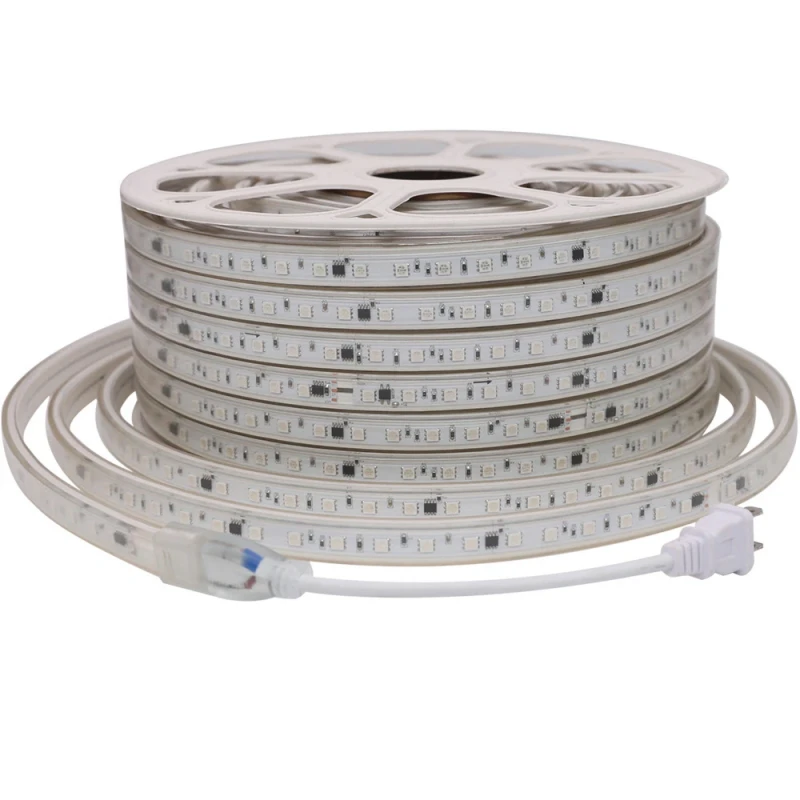
AC 110V/220V 可寻址LED灯条
型号:EAA10T060G
输入电压AC110V/220V
瓦特:10 瓦/米
LED 数量: SMD5050 60LEDs/m
色温:可寻址的RGB
IP 等级:IP68
可切割长度:1000mm
长度:50 米/卷
保修:2 年
价格:3美元
如果:
您需要精确的像素控制,例如单个 LED 动画或高级效果。
您的应用程序是室内或装饰性的,如标牌、展示柜或游戏室。
您需要在曲线、角落或自定义形状中灵活安装。
您对控制器、电源和编程有经验或支持。
照明是交互式或创意系统的一部分,例如基于 DMX 的节目或 SPI 效果。
如果您想购买 DC 可寻址 RGB LED 灯条,请单击此处查看更多产品: 直流可寻址灯带灯
简而言之:
AC = 更简单、更长、更长的户外
DC = 更智能、更灵活、更详细的控制
还是不确定? 混合方法也是可能的——一些项目使用交流带进行周边照明,而直流带用于焦点动画区域。
如何安全使用110V/220V交流LED灯
交流RGB LED灯条提供便利和长距离性能,但它们在高压(110V或220V)下运行,这需要在安装和使用过程中更加注意安全性。 以下是确保商业和室外环境安全可靠运行的关键准则:
1。 使用防水连接器和端盖
始终用 IP65+ 防水连接器和填充硅胶的端盖密封条带的两端。 这可以防止水进入和短路,特别是在户外或半开放式安装中。
2. 安装条形到遥不可及
由于电压高,请避免将条带放置在人们可能直接接触的地方。 将它们安装在高墙、天花板、屋檐或扩散器后面,以降低风险。
3.选择认证产品
仅使用带有 CE、ETL 或 UL 认证的条带,以确保符合安全标准。 可靠的内部驱动器和阻燃材料对于稳定性能至关重要。
4. 使用泄漏保护(RCD/RCBO)
始终在电源电路中安装剩余电流设备 (RCD) 或 RCBO。 这些安全开关在泄漏或短路时立即切断电源,保护人员和财产。
5. 操作时避免卷绕
不要在盘绕或紧密环路时操作交流 LED 灯条,因为这会导致过热。 始终将它们完全展开在散热表面,如铝或 PVC 通道。
6. 标记并保护所有电源点
清楚地标记所有交流连接点,并使用热收缩套筒或绝缘盒来保护暴露的端子。 保护控制箱和电源接口免受潮湿和破坏。
采取这些预防措施可确保您的 AC RGB 带安装不仅出色,而且安全、耐用且符合国际标准。

交流可寻址RGB灯带灯工厂
寻找交流和直流可寻址 RGB LED 灯条的一站式供应商?
Signlite 为商业、建筑和装饰项目提供全系列的高质量 RGB 照明解决方案。
我们生产110V/220V AC RGB 条和5V/12V/24V DC 像素条,支持从长距离建筑轮廓到详细的动画照明。 无论您需要即插即用的便利还是像素级控制,我们都能满足您的需求。
我们还支持定制——长度、防水级别、色彩效果和控制方法都可以根据您的项目需求进行定制。
